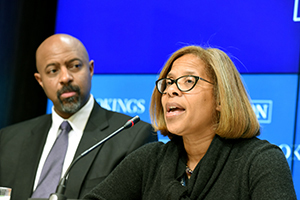
This is an archive of an Office of Justice Programs blog. This page is no longer updated and may contain outdated information and links that no longer function.
The Road to Justice Reform
Wednesday, December 21, 2016
By Assistant Attorney General Karol V. Mason

Yesterday, I had the privilege of joining colleagues from the White House, the Department of Justice and the Equal Employment Opportunity Commission for a roundtable conversation on civil rights and criminal justice reform hosted by the Hamilton Project of the Brookings Institution. The discussion gave those of us in the Obama Administration an opportunity to pause and reflect on the distance we have covered ??? and the distance we have yet to go ??? in our march toward a more fair and effective justice system.
In his July 2015 speech at the annual convention of the NAACP, President Obama spoke of the urgent need for change in our nation's criminal justice practices. "Our criminal justice system," he said, "is not as smart as it should be. It's not keeping us as safe as it should be. It is not as fair as it should be."
He went on to outline a broad vision for reform, one aimed at improving outcomes "in the community, in the courtroom, and in the cellblock." In fact, the President and his Administration have worked throughout his term to improve public safety, reverse mass incarceration, strengthen justice system-community relationships and enlarge opportunities for those at risk of justice involvement, especially our young people.
With crime at historic lows and incarceration rates in decline ??? and I am confident that data from 2015, once released, will reveal another dramatic reduction in the correctional population ??? clearly we have been doing something right as a country. The question now is, can we ride this momentum to even bigger changes? My answer is ??? we can and we must.
The Department of Justice and the Office of Justice Programs have been partnering with state, local and tribal stakeholders and national organizations to reduce the footprint of the criminal and juvenile justice systems ??? and together we are driving progress. We are breaking down a system that had become obsessed with retribution and blind to its own inefficiencies and inequities and replacing it with one dedicated to prevention, diversion alternatives and reentry services. These approaches are working, and for good reason: they are built on a solid foundation of data and research. If we continue along this path, we should expect our successes to multiply.
At the front end, initiatives like the National Forum on Youth Violence Prevention ??? one of the major efforts under My Brother's Keeper ??? are intended to reduce the number of people who enter the system. The Forum enables cities to design evidence-based, community-driven programs that create supportive environments for young people and counter their exposure to violence. Our site in Boston brought together police, youth and faith-based organizations to create a group of trained violence interrupters to mediate volatile street encounters. The city saw a 25 percent decrease in homicides between 2014 and 2015, its largest decline in 16 years.
At the point of contact with the justice system, we're encouraging pretrial decision-making based on risk rather than on money bail and discouraging overreliance on court fees and fines that too often punish defendants for their poverty rather than for any actual wrongdoing. On an even grander strategic level, we've collaborated with private partners to support states as they redirect funds from costly prison-building projects to more effective evidence-based options like community supervision and problem-solving courts. North Carolina, one of 29 states that have participated in the Justice Reinvestment Initiative, has closed 10 prisons and re-allocated funds to community-based treatment programs and 175 new probation officer positions, all while driving down crime rates.
On the back end of the system, we have prioritized programs and policies aimed at helping incarcerated and justice-involved individuals return to their communities prepared to live productive lives. The Federal Interagency Reentry Council, formally established by President Obama this year and co-chaired by the Attorney General and the Director of the White House Domestic Policy Council, has helped to expand access to jobs, housing, healthcare and education for the millions of Americans with a criminal record. Under the Second Chance Act, we have awarded almost 750 grants totaling more than $400 million to support juvenile and adult reentry programs across the country.
Measuring by these milestones, we have already travelled a considerable distance on the journey to reform. If we push on, as both science and common sense dictate we should, we will be rewarded with even bigger achievements in the future. Success, in the form of safer communities throughout the country and greater respect for the law from all America's citizens, awaits us down the road.

